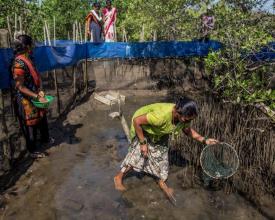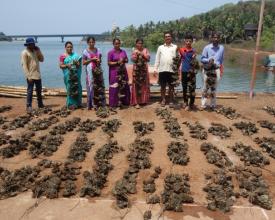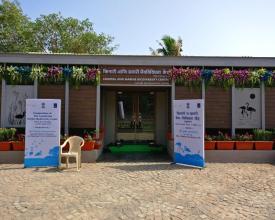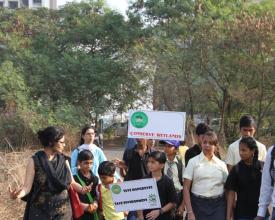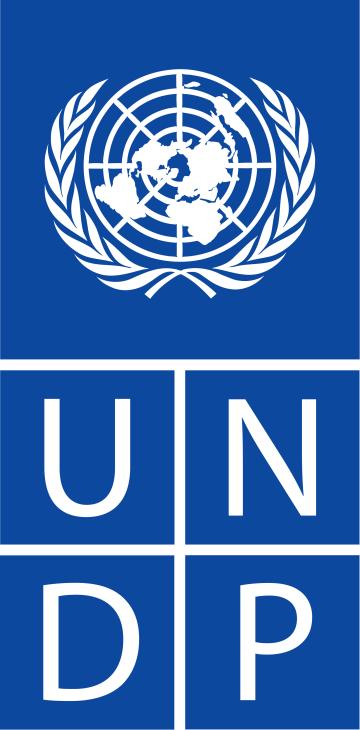Sustainable Financing Mechanism for Conservation of Mangroves and Marine Biodiversity
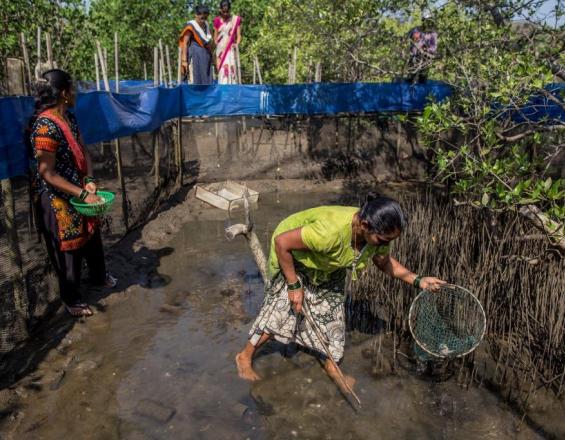
The Western Indian State of Maharashtra, with a coastline of 720 km has 30,000 hectares of mangroves, a third of which is in the metropolitan city of Mumbai and its suburbs. The Provincial Government of Maharashtra set up the Mangrove Cell in January 2012 for protection of the mangrove ecosystem. Despite teething troubles like staff shortage and financial constraints, the Mangrove Cell succeeded in increasing the mangrove cover of Maharashtra by 63% (from 186 sq. km in 2013 to 304 sq. km in 2017). To ensure sustainability of its mangrove protection efforts, and marine biodiversity conservation initiatives under its two externally aided projects (supported by UNDP-GEF and GIZ), the Mangrove Cell created the “Mangrove and Marine Biodiversity Conservation Foundation” of Maharashtra. From the interest generated on its corpus of about USD 20 million, the Foundation finances the conservation of its mangroves, two Marine Protected Areas and a host of marine conservation programmes.
Contexto
Défis à relever
- Mangroves, coastal and marine biodiversity conservation requires an integrated approach and substantial financing. Funds from the government are restricted to protection of mangroves in areas owned by the government. The Mangrove Foundation, which complements the on-going mangrove protection efforts, has enabled a broader approach that blends ecosystem conservation while supporting the livelihood of thousands of coastal communities along the Maharashtra coast.
- The Foundation implements sustainable aquaculture activities for the coastal communities. Since the success of these activities depends on a healthy ecosystem, this has particularly addressed the issue of conservation of mangroves in private lands and creeks which was not possible earlier.
Ubicación
Procesar
Summary of the process
- The Mangrove Foundation works in close coordination with the government department for planning and implementation of conservation programmes. While the government assumes the task of upholding the laws and regulation protecting the forests through the Mangrove Cell, the Foundation has been driving research, creating awareness, and initiating livelihood development programmes that support the conservation of mangroves, coastal and marine biodiversity. Funding from the Mangrove Foundation also helps the department tide over fluctuations in funding from the government.
- As described earlier, the Foundation ensures the sustainability of biodiversity conservation interventions initiated under the externally-aided projects. Successful models of conservation are being scaled up in the remaining areas of the state. At the same time, community institutions, partnerships and networks developed during the projects are championing the cause of mangrove conservation as a part of the efforts driven by the Mangrove Foundation.
- Successful efforts in mangrove protection, and biodiversity conservation, under UNDP-GEF and GIZ projects, were possible because of the government’s commitment to the cause of mangrove and marine biodiversity conservation.
Building Blocks
A dedicated unit for mangrove conservation
The provincial government of the state of Maharashtra in India, acting on the orders of the court, created a dedicated body in January 2012, to protect and conserve mangrove forests in the state. The dedicated unit, called the Mangrove Cell, started functioning as a part of the state level administrative body responsible for conservation of forests and wildlife. Considering the high level of encroachment in the mangrove areas, pressures of land conversion for real estate and industrial projects, and other anthropogenic factors, the government accorded the highest level of protection to mangrove forests by declaring them as “Reserved Forests”. Further, the Cell was empowered as per the statutory laws governing the management of forest resources in the country. Provisions were also made to engage field level personnel to safeguard these forests. With almost a third of the mangrove forests in the state falling within one of the most populated metropolises of the world, Mumbai¸ a specialised unit was formed to check and prevent incidences of encroachment and mangrove destruction within and around the city. Along with protection of mangrove forests, the Mangrove Cell is also responsible for conservation of coastal and marine ecosystems in the state of Maharashtra.
Enabling factors
- A judiciary framework that enabled the court to address an administrative gap and dictate the formation of a specialised unit for mangrove conservation.
- Laws and regulations that ensure conservation of forests in the country.
Lesson learned
In the past, conservation of mangrove, coastal and marine biodiversity was not one of the topics of focus in the conventional framework of managing forests in the country. Since management of these ecosystems require specialised knowledge and expertise, the formation of the Mangrove there has led to a more effective management of mangroves and marine ecosystem.
Landscape approach to conservation through externally-aided projects
- While the Mangrove Cell had assumed the task of protecting the mangrove forests in the state of Maharashtra, a broader approach was required for conservation of mangroves, the many creeks, mudflats, and other coastal ecosystems like beaches, rocky shores, coral reefs, that supported the rich biodiversity in the region. This, along with the conservation of marine biodiversity, fell under the mandate of the Mangrove Cell, a challenge that we were not prepared for, the Cell lacking in financial resources and manpower.
- Fortunately, the Cell, with the help of the government, was able to receive support from the UNDP-GEF. The UNDP-GEF supported project took on a landscape approach to the conservation of mangroves, and all coastal and marine biodiversity on a pilot basis. This support helped the Mangrove Cell address a wide range of interconnected conservation issues from sustainability of coastal fisheries, conservation of the endangered species, and sustainable livelihood development initiatives.
- The Indo-German project, supported by GIZ, further assisted the Mangrove Cell in taking up mangrove conservation issues particularly in the Thane Creek, one of the biggest creeks in Asia. The project made finance available to carry out necessary studies and biodiversity assessment of the Creek.
Enabling factors
- The Mangrove Cell was able to leverage the networks within the government to enter into agreements for the above projects.
- Both projects imbibed a multi-stakeholder approach to conservation. Multi-stakeholder discussions at different levels ensured participation of all relevant sectors from planning to implementation of the projects.
Lesson learned
Traditionally, the management of forests was driven mostly through the laws governing the protected areas. These projects, through technical and financial support, made it possible to take on a participatory approach to conservation of biodiversity. This approach has ensured the involvement of other government agencies, and most importantly, the local community, in the conservation of mangroves, coastal and marine biodiversity in the state.
Creation of a fund to sustain conservation programmes
- Partnerships with UNDP-GEF and GIZ resulted in the Mangrove Cell taking up conservation initiatives beyond the usual mandate of forest protection. These initiatives brought out success stories in conservation that were possible solely due to the support from these projects. To ensure sustainability of these interventions, efforts under these projects needed to be incorporated into the regular conservation on mangrove, coastal and marine biodiversity in the state of Maharashtra. Thus it was proposed to the provincial government that an autonomous organisation, the Mangrove Foundation, be formed that can take on the broader responsibility of mangrove and marine ecosystem conservation while the government body focuses on protection of mangrove forests.
- The Foundation was provisioned with a fund generated as a mitigation measure for development activities. This fund was in addition to the compensatory afforestation and mitigation funds calculated as per the Net Present Value of the mangrove forests affected due to the development projects.
- This interest generated from this fund has been utilised to recruit skilled personnel, and setting up effective governance for successful operations.
Enabling factors
- The additional mitigation measure for development projects is a provision only with the State of Maharashtra in the country.
- Partnerships with organisations and expert institutions developed under the externally-aided projects have helped in continuing conservation efforts being taken up by the Foundation.
Lesson learned
- Developing a commitment to address the larger goals of conservation has been possible by implementing and proving successful models initiated under the externally-aided projects. Involving key members and allied departments of the government, and obtaining their inputs in different aspects have been keys to ensure participation of all relevant stakeholders in the government. The board of governors of the Foundation has accordingly been constituted with representation from relevant wings of the government and the civil society.
- Separate project management units were created for implementation of project interventions under the externally-aided projects. To sustain the momentum in the newly created Foundation, dedicated teams have been created to take on the tasks of research and capacity building, and livelihood development initiatives that support the overall goal of conservation of mangroves, coastal and marine biodiversity.
Impacts
- Since mangrove conservation issues are closely linked to the livelihood security of coastal communities, effective conservation efforts require active participation and livelihood generation for the local community. Considering the role of sustainable livelihoods in the conservation of mangroves, the government has recently initiated a programme on “Mangrove conservation and livelihood generation” in villages with a significant mangrove cover. Thus, going beyond the government driven conservation efforts, the programme intends to create a community based conservation of mangrove, coastal and marine ecosystem. This has also increased the budgetary support for conservation of mangroves and coastal ecosystems by an annual USD 2 million.
- These livelihood interventions are being designed with women members of the community as the key drivers of the conservation programme. These committees, with support from the Mangrove Foundation, implement sustainable livelihood interventions that depend on a healthy coastal ecosystem. With more women members of these coastal communities being constantly encouraged to adopt suitable alternate livelihood options, there has been significant increase in their participation and decision making in the conservation efforts, and has increased their resilience to the effects of climate change.
Beneficiaries
Coastal communities, Fishers
Community-based organizations
Research and technical institutions
Independent researchers
Sustainable Development Goals
Story
In India, majority of funds for environment protection has traditionally been directed towards terrestrial areas. Although conservation of the coastal and marine ecosystems is implicit in the mandate of the government, the focus has been more on the boundaries of the land due to limited understanding of the marine environment. With increasing awareness, this has been gradually changed in the last few years.
In January 2012, the state of Maharashtra in India was the first in the country to set up a dedicated unit for the conservation of mangroves, the Mangrove Cell. The Cell was entrusted with the task of protecting the mangroves, coastal and marine biodiversity along the long 720 km coast. The Mangrove Cell realised early on, that to protect the biodiversity of the region, it was essential to collaborate with key players in the field of conservation.
Agreements with multilateral agencies like UNDP and GIZ supported the Cell with technical expertise and funds for an ecosystem approach to conservation. Through these Projects, the Cell was able to present a model of ecosystem conservation which extended beyond the traditional mangrove protection and plantation efforts. The Cell worked with the local communities to extend protection to mangroves, by promoting the organic link between healthy mangroves and revenue generation through sustainable livelihood activities.
To further support the cause for conservation, the government brought in legislative changes to mitigate the loss of mangroves. In a metropolitan like Mumbai, which is home to nearly one third of the mangrove cover in the state, urban infrastructural development often require diversion of mangrove areas. As per the norms required under the national legislations, the project proponents are required to support compensatory afforestation activities and provision mitigation funds calculated as per the Net Present Value of the mangrove forests affected due to the development projects. The provincial government, however, went a step ahead and called for additional funds for the protection of the coastal and marine ecosystems affected by developmental projects. This resulted in a corpus fund of USD 20 million. In order to utilise these funds in the most efficient manner, the government set up an autonomous organisation, the Mangrove Foundation, to take on the broader responsibility of mangrove and marine ecosystem conservation while the government body focuses on protection of mangrove forests.
